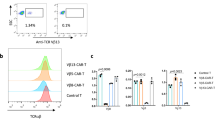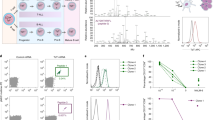Abstract
Mature T cell cancers are typically aggressive, treatment resistant and associated with poor prognosis. Clinical application of immunotherapeutic approaches has been limited by a lack of target antigens that discriminate malignant from healthy (normal) T cells. Unlike B cell depletion, pan–T cell aplasia is prohibitively toxic. We report a new targeting strategy based on the mutually exclusive expression of T cell receptor β-chain constant domains 1 and 2 (TRBC1 and TRBC2). We identify an antibody with unique TRBC1 specificity and use it to demonstrate that normal and virus-specific T cell populations contain both TRBC1+ and TRBC2+ compartments, whereas malignancies are restricted to only one. As proof of concept for anti-TRBC immunotherapy, we developed anti-TRBC1 chimeric antigen receptor (CAR) T cells, which recognized and killed normal and malignant TRBC1+, but not TRBC2+, T cells in vitro and in a disseminated mouse model of leukemia. Unlike nonselective approaches targeting the entire T cell population, TRBC-targeted immunotherapy could eradicate a T cell malignancy while preserving sufficient normal T cells to maintain cellular immunity.
This is a preview of subscription content, access via your institution
Access options
Access Nature and 54 other Nature Portfolio journals
Get Nature+, our best-value online-access subscription
$29.99 / 30 days
cancel any time
Subscribe to this journal
Receive 12 print issues and online access
$209.00 per year
only $17.42 per issue
Buy this article
- Purchase on Springer Link
- Instant access to full article PDF
Prices may be subject to local taxes which are calculated during checkout





Similar content being viewed by others
References
The Non-Hodgkin's Lymphoma Classification Project. A clinical evaluation of the International Lymphoma Study Group classification of non-Hodgkin's lymphoma. Blood 89, 3909–3918 (1997).
Vose, J., Armitage, J., Weisenburger, D. & International T-Cell Lymphoma Project. International peripheral T-cell and natural killer/T-cell lymphoma study: pathology findings and clinical outcomes. J. Clin. Oncol. 26, 4124–4130 (2008).
Weisenburger, D.D. et al. Peripheral T-cell lymphoma, not otherwise specified: a report of 340 cases from the International Peripheral T-cell Lymphoma Project. Blood 117, 3402–3408 (2011).
Gao, G. et al. A systematic review and meta-analysis of immunochemotherapy with rituximab for B-cell non-Hodgkin's lymphoma. Acta Oncol. 49, 3–12 (2010).
Bargou, R. et al. Tumor regression in cancer patients by very low doses of a T cell–engaging antibody. Science 321, 974–977 (2008).
Maude, S.L. et al. Chimeric antigen receptor T cells for sustained remissions in leukemia. N. Engl. J. Med. 371, 1507–1517 (2014).
Kochenderfer, J.N. et al. Chemotherapy-refractory diffuse large B-cell lymphoma and indolent B-cell malignancies can be effectively treated with autologous T cells expressing an anti-CD19 chimeric antigen receptor. J. Clin. Oncol. 33, 540–549 (2015).
Went, P. et al. Marker expression in peripheral T-cell lymphoma: a proposed clinical–pathologic prognostic score. J. Clin. Oncol. 24, 2472–2479 (2006).
Notarangelo, L.D., Kim, M.-S., Walter, J.E. & Lee, Y.N. Human RAG mutations: biochemistry and clinical implications. Nat. Rev. Immunol. 16, 234–246 (2016).
Pui, C.H. et al. Heterogeneity of presenting features and their relation to treatment outcome in 120 children with T-cell acute lymphoblastic leukemia. Blood 75, 174–179 (1990).
Jamal, S. et al. Immunophenotypic analysis of peripheral T-cell neoplasms. A multiparameter flow cytometric approach. Am. J. Clin. Pathol. 116, 512–526 (2001).
Palomero, T. et al. Recurrent mutations in epigenetic regulators, RHOA and FYN kinase in peripheral T cell lymphomas. Nat. Genet. 46, 166–170 (2014).
Delves, P.J., Martin, S.J., Burton, D.R. & Roitt, I.M. Essential Immunology (Wiley-Blackwell, 2011).
Sims, J.E., Tunnacliffe, A., Smith, W.J. & Rabbitts, T.H. Complexity of human T-cell antigen receptor β-chain constant- and variable-region genes. Nature 312, 541–545 (1984).
Tunnacliffe, A., Kefford, R., Milstein, C., Forster, A. & Rabbitts, T.H. Sequence and evolution of the human T-cell antigen receptor β-chain genes. Proc. Natl. Acad. Sci. USA 82, 5068–5072 (1985).
Dickinson, A.M. et al. In situ dissection of the graft-versus-host activities of cytotoxic T cells specific for minor histocompatibility antigens. Nat. Med. 8, 410–414 (2002).
Viney, J.L., Prosser, H.M., Hewitt, C.R., Lamb, J.R. & Owen, M.J. Generation of monoclonal antibodies against a human T cell receptor β chain expressed in transgenic mice. Hybridoma 11, 701–713 (1992).
Reff, M.E. et al. Depletion of B cells in vivo by a chimeric mouse human monoclonal antibody to CD20. Blood 83, 435–445 (1994).
Ricciardelli, I. et al. Towards gene therapy for EBV-associated posttransplant lymphoma with genetically modified EBV-specific cytotoxic T cells. Blood 124, 2514–2522 (2014).
Swerdlow, S.H. et al. WHO Classification of Tumours of Haematopoietic and Lymphoid Tissues (International Agency for Research on Cancer, 2008).
Pulè, M.A. et al. A chimeric T cell antigen receptor that augments cytokine release and supports clonal expansion of primary human T cells. Mol. Ther. 12, 933–941 (2005).
Philip, B. et al. A highly compact epitope-based marker/suicide gene for easier and safer T-cell therapy. Blood 124, 1277–1287 (2014).
Freeman, J.D., Warren, R.L., Webb, J.R., Nelson, B.H. & Holt, R.A. Profiling the T-cell receptor β-chain repertoire by massively parallel sequencing. Genome Res. 19, 1817–1824 (2009).
Rosenberg, W.M., Moss, P.A. & Bell, J.I. Variation in human T cell receptor Vβ and Jβ repertoire: analysis using anchor polymerase chain reaction. Eur. J. Immunol. 22, 541–549 (1992).
Brüggemann, M. et al. Powerful strategy for polymerase chain reaction–based clonality assessment in T-cell malignancies. Report of the BIOMED-2 Concerted Action BHM4 CT98-3936. Leukemia 21, 215–221 (2007).
Stevenson, F.K. et al. Antibodies to shared idiotypes as agents for analysis and therapy for human B cell tumors. Blood 68, 430–436 (1986).
Hamblin, T.J. et al. Initial experience in treating human lymphoma with a chimeric univalent derivative of monoclonal anti-idiotype antibody. Blood 69, 790–797 (1987).
Ramos, C.A. et al. Clinical responses with T lymphocytes targeting malignancy-associated κ light chains. J. Clin. Invest. 126, 2588–2596 (2016).
Davila, M.L. et al. Efficacy and toxicity management of 19–28z CAR T cell therapy in B cell acute lymphoblastic leukemia. Sci. Transl. Med. 6, 224ra25 (2014).
Porter, D.L., Levine, B.L., Kalos, M., Bagg, A. & June, C.H. Chimeric antigen receptor–modified T cells in chronic lymphoid leukemia. N. Engl. J. Med. 365, 725–733 (2011).
Mamonkin, M., Rouce, R.H., Tashiro, H. & Brenner, M.K. A T-cell-directed chimeric antigen receptor for the selective treatment of T-cell malignancies. Blood 126, 983–992 (2015).
Pinz, K. et al. Preclinical targeting of human T-cell malignancies using CD4-specific chimeric antigen receptor (CAR)-engineered T cells. Leukemia 30, 701–707 (2016).
Boulter, J.M. et al. Stable, soluble T-cell receptor molecules for crystallization and therapeutics. Protein Eng. 16, 707–711 (2003).
Garboczi, D.N. et al. Assembly, specific binding, and crystallization of a human TCR-αβ with an antigenic Tax peptide from human T lymphotropic virus type 1 and the class I MHC molecule HLA-A2. J. Immunol. 157, 5403–5410 (1996).
Wyer, J.R. et al. T cell receptor and coreceptor CD8αα bind peptide–MHC independently and with distinct kinetics. Immunity 10, 219–225 (1999).
Straathof, K.C. et al. An inducible caspase 9 safety switch for T-cell therapy. Blood 105, 4247–4254 (2005).
Acknowledgements
We would like to thank M. Owen and J. Viney for helpful discussions and H. Stauss (University College London) for provision of the Jurkat TCR-null cell line. The RD114 viral envelope plasmid was a gift from M. Collins (University College London). PeqPam-env, a Gag-Pol expression plasmid, was a gift from E. Vanin (Baylor College of Medicine). P.M.M. was supported by a studentship from Cancer Research UK. M.A. Pule and T.M. were supported by the UK National Institute of Health Research University College London Hospital Biomedical Research Centre. A.U.A. and M.L. are supported by Cancer Research UK. D.K.C. is a Wellcome Trust Career Development Fellow. A.K.S. is a Wellcome Trust Senior Investigator. K.S.P. is the Scientific Director of the National Institute for Health Research Blood and Transplant Unit for stem cell transplantation and immunotherapy. This project was supported by grants from the Kay Kendall Leukaemia Fund (M.A. Pule and P.M.M.; KKL872) and Innovate UK (M.A. Pule and T.M.; 102571).
Author information
Authors and Affiliations
Contributions
P.M.M. designed and performed the experimental work and wrote the manuscript. P.A.W. performed experimental work. B.P. designed and performed in vivo experiments. I.R. generated and tested EBV-specific CTLs. A.U.A. performed immunohistochemistry. S.C.O., D.K.C. and A.K.S. produced soluble TCR molecules, performed surface plasmon resonance analysis and wrote the manuscript. M.L. and A.K.S. identified and characterized iNKTs. G.G., J.S. and M.A. Piris supplied clinical samples. K.S.P. and D.C.L. provided advice and support and wrote the manuscript. T.M. optimized and analyzed immunohistochemical staining and wrote the manuscript. M.A. Pule conceived the idea, designed the experimental work and wrote the manuscript.
Corresponding author
Ethics declarations
Competing interests
P.M.M. and M.A. Pule have patent rights for the targeting of TRBC for diagnosis and treatment of T cell malignancies (patent application, World Intellectual Property Organization, WO 2015132598 A1). P.M.M., B.P., S.C.O., K.S.P., D.C.L. and M.A. Pule are shareholders in Autolus, which has licensed anti-TRBC1 technology. S.C.O. and M.A. Pule are also employees of Autolus.
Supplementary information
Supplementary Figures
Supplementary Figures 1–6 (PDF 5488 kb)
Rights and permissions
About this article
Cite this article
Maciocia, P., Wawrzyniecka, P., Philip, B. et al. Targeting the T cell receptor β-chain constant region for immunotherapy of T cell malignancies. Nat Med 23, 1416–1423 (2017). https://doi.org/10.1038/nm.4444
Received:
Accepted:
Published:
Issue Date:
DOI: https://doi.org/10.1038/nm.4444
This article is cited by
-
The constitutive activation of STAT3 gene and its mutations are at the crossroad between LGL leukemia and autoimmune disorders
Blood Cancer Journal (2024)
-
Generation and optimization of off-the-shelf immunotherapeutics targeting TCR-Vβ2+ T cell malignancy
Nature Communications (2024)
-
Dual T-cell constant β chain (TRBC)1 and TRBC2 staining for the identification of T-cell neoplasms by flow cytometry
Blood Cancer Journal (2024)
-
TRBC1-targeting antibody–drug conjugates for the treatment of T cell cancers
Nature (2024)
-
Structure-guided engineering of immunotherapies targeting TRBC1 and TRBC2 in T cell malignancies
Nature Communications (2024)



